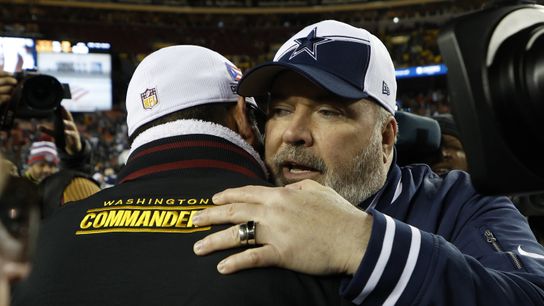Trailing 39-30 with 4:57 to play on Sunday, Mike McCarthy had a decision to make. His Dallas Cowboys had just scored to cut their 15-point deficit to nine, and McCarthy kept his offense on the field.
Whereas most coaches would have kicked the PAT to make it a "one-score game," McCarthy went for two.
The try failed -- the Cowboys ran an option play that gave Ezekiel Elliott the ball at the 8-yard line -- but the decision, I believe, was the correct one.
I also quickly learned, on Twitter and in various text threads with friends and family, that this is an unpopular one, but I don't care. It's the right one, and I'm willing to die on this hill.
The thinking is this: Kicking the PAT to make the score 39-31 does make it a "one-score game," but only in theory.
For the sake of argument, let's assume the Cowboys had kicked the PAT and cut their deficit to eight. When the defense forced a punt two minutes later, the Dallas offense took over at their own 24 with 2:52 remaining.
The conventional wisdom, then, is to burn clock. After all, it is a "one-score game," right? Can you imagine the roasting McCarthy would receive if his Cowboys had scored with a minute left, and the Falcons answered with a field goal to win 42-39?
But let's just say Dallas executed that final drive perfectly, and Zeke crossed the goal line with 15 seconds left. The Cowboys are now just a play away from forcing overtime. This proves kicking the PAT after the first touchdown was the correct play, doesn't it? Not necessarily, and the reason is this:
YOU CAN'T ASSUME YOU CONVERT THE 2-POINT CONVERSION.
Let's say that again, in bold this time for the folks in the back.
YOU CAN'T ASSUME YOU CONVERT THE 2-POINT CONVERSION.
A 2018 study by ESPN, dating back to 2001, found 2-point tries succeeded 47.7 percent of the time. This study by SB Nation, examining all 2-point tries from 2015-19, found a success rate of 50.1 percent.
Either way, you're talking about a coin flip play. And what happens if that coin lands on the wrong side with 15 seconds left in the game?
If you go for two after your first touchdown and succeed, you can move forward with the knowledge you truly are in a one-score game. If you fail, you can know budget the final five minutes accordingly without lulling yourself into a false sense of security, that an 8-point deficit equates to a one-score game.
The one argument I can see for delaying the 2-point conversion as long as possible? The human element. A team that believes it's in a one-score game could be more likely to fight harder than one that knows it's in a two-score game.
That's a matter of debate -- one that myself and McCarthy happen be on the correct side of.
"I think that's the wrong call to kick the extra point there," McCarthy said after the game. "You'd rather know if it's a two-score game at the earliest time instead of taking it all the way down to the end for a two-point (try) at the end. I can't tell you how many conversations I've been involved in in this particular situation.
"You go for two there just to make it clear, with a little over four minutes (left), if we were going to be in a one-score game or a two-score game."
Come back next time, when Professor Z argues why coaches should also go for two when trailing by 14.
